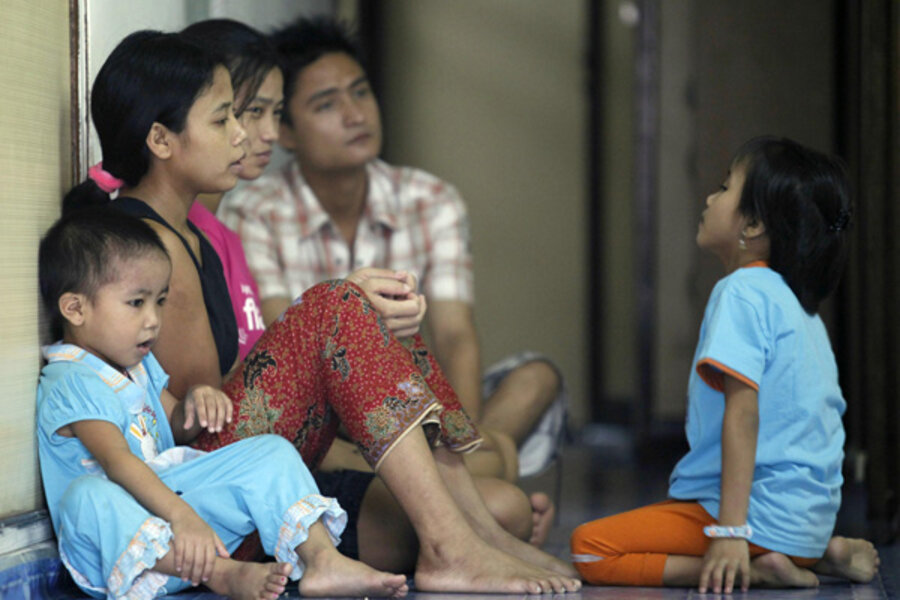Australia refugee swap with Malaysia faces key test
Loading...
| Bangkok, Thailand
A controversial refugee-swap agreement between Australia and Malaysia could be put to the test next week following the interception of a boatload of 54 asylum seekers on the way to Australia.
The group was redirected to an offshore detention center on Thursday. Now, the detainees are due to be airlifted to Malaysia, which has agreed to take in 800 asylum seekers from Australia, which is a magnet for Asians fleeing war and poverty. In return, Australia will resettle 4,000 refugees registered in Malaysia over the next four years. The agreement, signed July 25, is seen as an attempt by Australian Prime Minister Julia Gillard to shore up her minority government by acting tough on illegal migration, a hot-button issue.
In a new-media twist, Australia plans to film the forced return of the detainees and post videos on Youtube and Facebook, with faces pixilated to hide their identities. The government has produced online videos in several languages aimed at convincing refugees not to attempt the hazardous sea crossing to Australia.
But new media or not, critics don't seem so impressed. Some say the deal, dubbed the "Malaysia Solution," runs roughshod over Australia’s obligations to protect asylum seekers and may encourage other countries to follow suit. “We’re concerned it could start a wider erosion of protection for refugees throughout the Asia-Pacific region. The talk in the neighborhood will be ‘hey, if Australia can do it, why can’t we?’ ” says Phil Robertson, deputy director for Asia for Human Rights Watch.
Human rights groups say Australia is acting unlawfully by sending asylum seekers to Malaysia, which hasn’t signed the UN Convention on Refugees and has a poor record for treating refugees, who aren’t allowed to work and whose children can't attend school. In response, Malaysia has agreed to make an exception for those transferred from Australia, who will be resettled “in accordance with human rights standards,” it said in a statement.
Australian officials claim that the expulsions will undercut demand for the services of human traffickers, who profit from the seaborne trade. Migrants pay tens of thousands of dollars to travel via Malaysia to Indonesia, from where rickety vessels set sail for Australia. More than 6,500 people arrived last year by this route, mostly Afghans, Sri Lankans, Pakistanis, Iraqis, and Burmese.
Officials are quick to admit it isn't likely to completely end the risky practice, as Immigration Minister Chris Bowen told Australian radio: “We know that people smugglers will be out there saying, Look this won’t apply to you’, because they’re desperate to make money off desperate people.”
In the past, Australia has diverted boat people to Pacific Islands to process asylum claims. Ms. Gillard has said Papua New Guinea may revive that role after Malaysia takes in its quota. Australia also uses Christmas Island, a territory off its northwest shore, to detain refugees, a practice that has been criticized by the UN High Commission for Refugees (UNHCR). The 54 asylum seekers intercepted last week were offloaded there Thursday as a first step toward their expulsion.
Australia’s conservative opposition accuses Gillard and her predecessor, Kevin Rudd, of weakening border controls that had previously kept out illegal migrants. Australians argue that people smugglers are exploiting their generosity toward refugees who apply via official channels, though rights groups point out that Australia is far less accommodating than most European countries on a per capita basis.
Meanwhile in Malaysia
For refugees in Malaysia, the deal holds out the hope of resettlement to Australia via legal channels. UNHCR has registered 94,400 asylum seekers and refugees in Malaysia, mostly from Burma’s ethnic minorities, as well as Sri Lankans, Somalis, Iraqis and Afghans. Around 19,000 are minors. Many refugees have waited several years for resettlement, and the prospect of an additional 4,000 places has raised their expectations.
Sri Ranjini Baskaran, a Sri Lankan Tamil who fled to Malaysia in 2006 and runs an advocacy group, says Sri Lankans are worried that they could miss out. She complained that UNHCR hadn’t explained who would be eligible for the Australian program. But staying in Malaysia, where refugees often live in fear of being arrested and detained as illegal migrants, wasn’t a long-term option, she says.
“It’s very difficult for refugees to live in a country where they have no basic rights and no guarantee for the future. They may feel they have no choice but to risk leaving [by boat],” she says.
Yante Ismail, a spokeswoman for UNHCR in the Malaysian capital, Kuala Lumpur, said that the right to work and education granted to refugees expelled from Australia didn’t apply to those already in Malaysia. But she said it could lead to changes in the treatment of the larger refugee population.
"While the explicit protections … only apply to those transferred from Australia, UNHCR hopes that over time we will see a continued improvement in conditions for all refugees in Malaysia,” she says.





